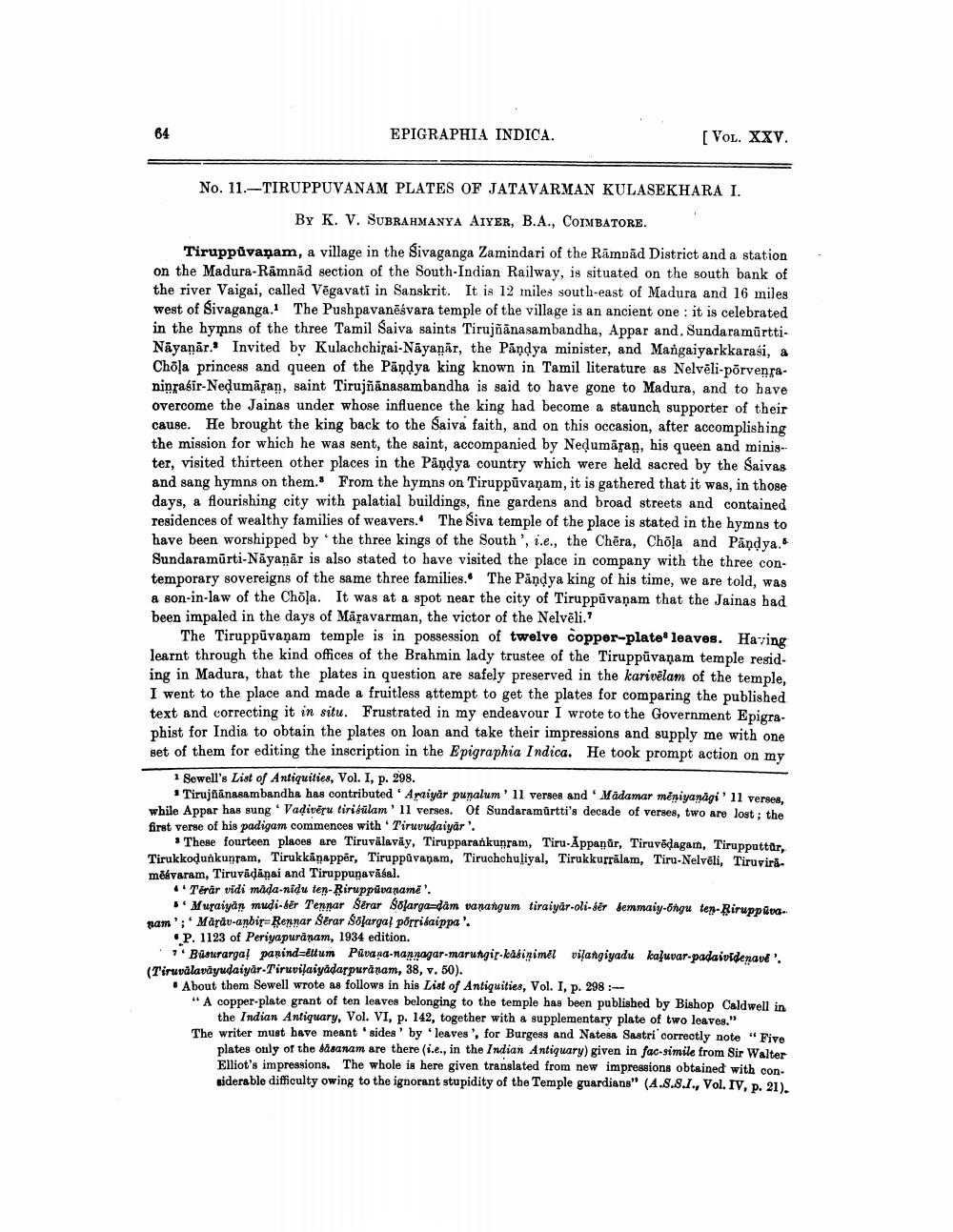________________
64
EPIGRAPHIA INDICA.
[VOL. XXV.
No. 11.-TIRUPPUVANAM PLATES OF JATAVARMAN KULASEKHARA I. By K. V. SUBRAHMANYA AIYER, B.A., COIMBATORE.
Tiruppuvaņam, a village in the Sivaganga Zamindari of the Ramnad District and a station on the Madura-Ramnad section of the South-Indian Railway, is situated on the south bank of the river Vaigai, called Vegavati in Sanskrit. It is 12 miles south-east of Madura and 16 miles. west of Sivaganga. The Pushpavanesvara temple of the village is an ancient one: it is celebrated in the hymns of the three Tamil Saiva saints Tirujñanasambandha, Appar and. SundaramürttiNāyaṇar. Invited by Kulachchirai-Nāyaṇar, the Pandya minister, and Mangaiyarkkarasi, a Chola princess and queen of the Pandya king known in Tamil literature as Nelveli-põrvenraninrasir-Nedumaran, saint Tirujñānasambandha is said to have gone to Madura, and to have overcome the Jainas under whose influence the king had become a staunch supporter of their cause. He brought the king back to the Saiva faith, and on this occasion, after accomplishing the mission for which he was sent, the saint, accompanied by Neḍumaran, his queen and minis-ter, visited thirteen other places in the Pandya country which were held sacred by the Saivas and sang hymns on them. From the hymns on Tiruppuvaņam, it is gathered that it was, in those days, a flourishing city with palatial buildings, fine gardens and broad streets and contained residences of wealthy families of weavers. The Siva temple of the place is stated in the hymns to have been worshipped by the three kings of the South', i.e., the Chera, Chōla and Pandya. Sundaramurti-Nayanar is also stated to have visited the place in company with the three contemporary sovereigns of the same three families. The Pandya king of his time, we are told, was a son-in-law of the Chola. It was at a spot near the city of Tiruppuvaņam that the Jainas had been impaled in the days of Maṛavarman, the victor of the Nelvēli."
The Tiruppuvanam temple is in possession of twelve copper-plate leaves. Having learnt through the kind offices of the Brahmin lady trustee of the Tiruppuvanam temple residing in Madura, that the plates in question are safely preserved in the karivelam of the temple, I went to the place and made a fruitless attempt to get the plates for comparing the published text and correcting it in situ. Frustrated in my endeavour I wrote to the Government Epigraphist for India to obtain the plates on loan and take their impressions and supply me with one set of them for editing the inscription in the Epigraphia Indica. He took prompt action on my
1 Sewell's List of Antiquities, Vol. I, p. 298.
Tirujñānasambandha has contributed' Araiyar punalum' 11 verses and Madamar mēniyanagi' 11 verses, while Appar has sung Vadiveru tiriéülam' 11 verses. Of Sundaramürtti's decade of verses, two are lost; the first verse of his padigam commences with 'Tiruvudaiyar'.
These fourteen places are Tiruvalavay, Tirupparankuṇram, Tiru-Appanar, Tiruvēḍagam, Tirupputtür, Tirukkodunkunram, Tirukkäṇapper, Tiruppavanam, Tiruchchuliyal, Tirukkurrālam, Tiru-Nelveli, Tiruvirăměévaram, Tiruvaḍāṇai and Tiruppuṇavāśal.
Terar vidi mada-nidu ten-Ṛiruppuvanamē".
Muraiyan mudi-ser Tennar Serar Solarga-dam vanangum tiraiyar-oli-ser semmaiy-öngu ten-Riruppuva. nam'; Mārav-anbir-Rennar Serar Solargal porrisaippa'.
P. 1123 of Periyapuranam, 1934 edition.
Busurargal panind-ettum Pavana-nannagar-marungir-kabiniměl vilangiyadu kaluvar-padaivideņave'. (Tiruvalavayudaiyar-Tiruvilaiyadarpuranam, 38, v. 50).
About them Sewell wrote as follows in his List of Antiquities, Vol. I, p. 298 :--
"A copper-plate grant of ten leaves belonging to the temple has been published by Bishop Caldwell in the Indian Antiquary, Vol. VI, p. 142, together with a supplementary plate of two leaves." The writer must have meant sides' by 'leaves', for Burgess and Natesa Sastri correctly note "Five plates only of the sasanam are there (i.e., in the Indian Antiquary) given in fac-simile from Sir Walter Elliot's impressions. The whole is here given translated from new impressions obtained with considerable difficulty owing to the ignorant stupidity of the Temple guardians" (4.8.8.I., Vol. IV, p. 21).




